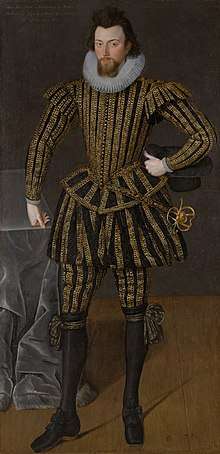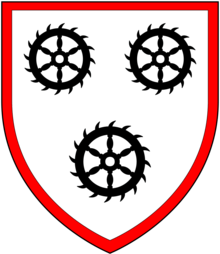John Scott (soldier)
Sir John Scott (b c 1564 d. 24 September 1616), of Scot's Hall and of Nettlestead Place in Kent, was an English soldier, Member of Parliament (MP) and an early investor in the Colony of Virginia. The second son of Sir Thomas Scott, he served as captain of a band of lancers in the English army in the Netherlands, and in 1588 was knighted for his services. In 1597 he commanded a ship in the expedition to the Azores. In 1601, Scott was implicated in Essex's Rebellion but succeeded in clearing himself, and in the same year was a parliamentary candidate for Kent in 1601. He was unsuccessful on this first attempt, but was elected its MP in the Parliament of 1604 and for Maidstone in the Addled Parliament of 1614. He became a member of the Council for Virginia in 1607, the year when that colony was re-established, subscribing £75, and was a councillor of the Virginia Company of London in 1609. He died in 1616 and was buried at Brabourne in Kent.
| John Scott | |
|---|---|
 | |
| Died | 1616 |
| Spouse(s) | Elizabeth Stafford, Catherine Smythe Scott |
| Parent(s) | |
| Position held | Member of the 1604-11 Parliament, Member of the 1614 Parliament |

.jpg)
.jpg)
Early Life
John Scott was born about 1564 according to his HOP biography.[1]
Marriages
Scott married twice, but had no issue:[2]
- Firstly, in 1590, to Elizabeth Stafford (d. 6 February 1599), widow of Sir William Drury (30 May 1550 – 18 January 1590) of Hawstead, Suffolk, and daughter of Sir William Stafford (d. May 1556) by his wife, Dorothy Stafford (1 October 1526 – 22 September 1604), granddaughter of Edward Stafford, 3rd Duke of Buckingham. By his first marriage, Scott was the stepfather of Sir Robert Drury, friend of the poet, John Donne. Without issue.
- Secondly, before 17 September 1599, he married Katherine Smythe, widow of Sir Rowland Hayward, Lord Mayor of London, and daughter of Thomas Smythe (d.1591). She was baptised Katherine Smith on 6 Dec 1561 at All Hallows Lombard Street, City of London and is recorded in the Smythe pedigree taken during the Heraldic Visitation of London in 1568 and the Visitation of Kent in 1619 as the daughter of Thomas Smythe and Alice Judde. Without issue.
Notes
- White 1918, p. 544; Rowe 2004.
References
_OfNettlestead_Kent.png)
- Brown, Alexander (1897). The Genesis of the United States. II. Boston: Houghton Mifflin and Company. Retrieved 4 March 2013.CS1 maint: ref=harv (link)
- Richardson, Douglas (2011). Everingham, Kimball G. (ed.). Magna Carta Ancestry: A Study in Colonial and Medieval Families. IV (2nd ed.). Salt Lake City. ISBN 978-1460992708. Retrieved 2 March 2013.
- Rigg, James McMullen (1897). . In Lee, Sidney (ed.). Dictionary of National Biography. 51. London: Smith, Elder & Co. pp. 105–7.CS1 maint: ref=harv (link)
- White, Emma Siggins (1918). Genealogical Gleanings of Siggins and Other Pennsylvania Families. Kansas City, Missouri: Tiernan-Dart Printing Company. p. 544. Retrieved 4 March 2013.
sir thomas scott elizabeth baker sir john scott.
CS1 maint: ref=harv (link) - . Dictionary of National Biography. London: Smith, Elder & Co. 1885–1900.
- J. E. Neale, The Elizabethan House of Commons (London: Jonathan Cape, 1949)